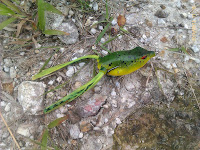This is perhaps the most popular bottom rig used anywhere in the world due to it's simple construction & effectiveness. Most tie their rig using a combination of hook, leader, hollow sinker & barrel swivel. Personally, I am not in favor of too many terminal tackles on a rig. Preferring to have just the minimal, I tie mine differently as I'll illustrate here.
The reason for the rig's effectiveness is it will allow the fish to pull bait gently without spooking it. This way, the angler will know if there is a take & get ready to set the hook. With a circle hook, there is no need to set the hook as the circle-hooks are designed in such a way fish will hook themselves on the lips when they try to spit the bait out.
Under what conditions should I use a Sliding Sinker Rig?* when the
basic bottom rig is too light & you need to cast to a further distance.
* when you need to present a smaller, lighter bait so you need a sinker on your rig.
* in rivers or saltwater fishing.
The components to assemble the rig Size# 1/0 circle hook. (Adjust size according to target fish.)
15" of 50lb clear mono leader of diameter 0.65mm.
28" of 20lb clear mono line of diameter 0.30mm
Long oval hollow sinker. (Adjust size according to casting distance & bait size)
STEP1
Snell the hook with the 50lb mono leader. With a 0.65mm diameter leader, you can be assured of catching even some toothy fishes the likes of Pacu & Snakeheads which will take them some effort to bite off. It would also be less visible compared to trace wires.
STEP2
Join the 50lb leader with the 20lb line using an Albright knot. Make about 20 turns to form the Albright. For stronger & more secured join, apply some fast 4min dry glue onto the knot. [Optional] You may want to add a bead on top of the Albright. Instructions on how to tie an
Albright Knot
STEP3
Insert 20lb line through the sinker & slide it down to the Albright knot area. The much thicker diameter of the Albright knot will hold the sinker in place without it sliding all the way down to the hook. If the sinker's hollowed hole is still larger than the Albright knot, just use a pair of pliers to crimp & tighten the opening to reduce the diameter just a little bit yet the sinker is still able to slide up & down with minimal friction.
Done! Now you are ready to fish.
I find that by rigging without a swivel, the presentation is more natural. This is an effective rig for Pacu, Tilapia & Carp. Fishes that feed at the bottom. Some other modifications that I do is to color the sinker black to further mask it.
UPDATE - 12th September 2012 - Duel Hook Sliding Sinker RigLately, I've been experimenting with a duel-hook sliding sinker rig & the results is most pleasing. I've already landed a few whoppers with this rig. Here's how it looks.
Instructions on how to construct the rig.
(1) Take a length of 14 to 20inch of either mono or braided line as leader. Tie a hook by snelling them on each end.
(2) Take the mid-section of the leader & tie a Palomar knot onto a barrel swivel.
(3) Tie a leader onto the other ring of the barrel swivel either with a Palomar or Clinch knot.
(4) Slide a sinker through the upper leader & terminate the end with a loop knot. DONE!
This rig is best used for dough or groundbait fishing but can be effective for dead baits too.














































